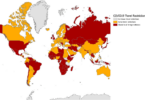Planning a trip to Australia can be an exhilarating experience with its vast landscapes, bustling cities, and unique wildlife. Whether you’re a first-time visitor or a seasoned traveler, organizing your journey Down Under can seem daunting. In this guide, we’ll explore everything from budgeting and accommodations to the best road trip apps and must-see destinations, providing you with all the essential information for a memorable Australian adventure.
Budgeting for Your Australian Adventure
When planning your trip, one of the first things to consider is your budget. Australia offers a range of experiences, from budget-friendly to luxurious, depending on how much you are willing to spend.
For a two-week stay, the average tourist can expect to spend around $2,200. This amount covers accommodation, meals, and activities.
Budget travelers might get by with $900, while those seeking luxury can spend upwards of $6,500. If you’re considering a road trip, factor in fuel and campsite fees. For example, a one-year road trip covering 25,000 km might set you back around $25,400 for car and caravan costs.
Knowing your budget will help you tailor your trip to suit your financial situation, ensuring you get the most out of your time in Australia.
Choosing the Best Road Trip Planner Apps
Australia is known for its scenic road trips, and using the right trip-planning apps can significantly enhance your experience. Here’s a rundown of the best road trip apps every traveler should consider:
1. Petty: For finding the cheapest fuel prices.
2. Alltrails: Perfect for hikers and outdoor enthusiasts.
3. Flush: Helps you locate public restrooms, which is particularly useful during long drives.
4. Plugshare: Ideal for those using electric vehicles, showing charging stations.
5. Wikicamps AU: A comprehensive camping guide for campgrounds across Australia.
6. Stippl: Allows you to plan your itinerary, manage budgets, and even create packing lists.
7. Roadtrippers: Provides detailed maps and travel guides, making it a great all-in-one app.
8. Splitwise: Perfect for group travel, allowing you to split bills among friends or family.
These apps will simplify your road trip planning and ensure a smooth and enjoyable journey.
Best Times of Year to Travel to Australia
Australia is a vast country with diverse climates, so the best time to visit depends on the regions you plan to explore. Generally, the most favorable time to travel is during the Australian summer, which runs from December to February. During this time, the weather is ideal for visiting the beaches and exploring the outdoor attractions in the southern parts of the country.
However, if you’re heading to the northern regions, like the Great Barrier Reef, it’s best to visit during the winter months (June to August) when the temperatures are cooler, and the chance of rain is lower. Always research the specific regions you’re visiting to plan for the best weather conditions.
Choosing Destinations and Itineraries
When it comes to picking destinations, Australia offers something for everyone. Here are some of the must-see spots to include in your itinerary:
1. Sydney: Known for its iconic Opera House and Harbor Bridge.
2. Melbourne: Famous for its art, food scene, and coffee culture.
3. The Great Barrier Reef: A UNESCO World Heritage site and a paradise for divers.
4. Uluru: A sacred Aboriginal site that showcases Australia’s unique outback landscape.
5. Tasmania: Ideal for nature lovers, with lush forests and wildlife.
6. The Great Ocean Road: A scenic coastal drive that takes you through breathtaking landscapes.
Mixing city life with natural wonders will ensure a diverse and enriching travel experience.
How to Travel Around Australia on a Budget
Traveling in Australia doesn’t have to break the bank. Here are some budget-friendly tips to consider:
1. Use Public Transport: Australia has an extensive public transportation system, including buses, trains, and ferries. These are often cheaper and more environmentally friendly than flying or renting a car.
2. Stay in Hostels or Campsites: Instead of luxury hotels, opt for budget-friendly accommodations like hostels, caravan parks, or free campsites. Wikicamps AU can help you find suitable spots.
3. Cook Your Own Meals: To save on food costs, shop at local supermarkets and cook your own meals, especially if you’re staying in accommodations with kitchen facilities.
4. Look for Free Attractions: Many of Australia’s best attractions are free, such as national parks, beaches, and walking tours.
These tips will help you keep costs down while still enjoying all that Australia has to offer.
Finding the Perfect Accommodation in Australia
When it comes to accommodation, Australia has a variety of options for every type of traveler. Whether you’re looking for luxury resorts or budget-friendly hostels, there’s something for everyone.
1. Hotels: Australia boasts a wide range of hotels, from high-end luxury resorts to budget chains like Ibis and Travelodge.
2. Hostels: For backpackers and budget-conscious travelers, hostels are a great option. Many hostels offer shared and private rooms at affordable prices.
3. Airbnb: If you prefer a more homey feel, Airbnb offers unique accommodation options, from beachside cottages to city apartments.
4. Camping: For the outdoor enthusiast, Australia has numerous campgrounds where you can set up a tent or park a campervan. This is an excellent option for those looking to explore Australia’s natural beauty.
Choosing the right accommodation can greatly enhance your travel experience, allowing you to rest and recharge after a day of exploring.
How to Plan a Perfect Australian Road Trip
Australia is the perfect country for a road trip, with long, scenic highways connecting stunning coastal towns, national parks, and vibrant cities. Here’s how to plan the ultimate Australian road trip:
1. Choose Your Route: Some popular road trip routes include the Great Ocean Road, the Sydney to Brisbane drive, and the Outback Explorer from Adelaide to Darwin.
2. Prepare Your Vehicle: Whether you’re renting a car or driving your own, ensure it’s roadworthy and equipped with necessary supplies, especially if you’re venturing into remote areas.
3. Plan Stops and Breaks: Make sure to plan rest stops and overnight stays along your route. Apps like Wikicamps AU can help you find campsites, while Roadtrippers can assist with itinerary planning.
4. Pack Smart: Bring essentials like food, water, maps, and a first-aid kit, especially if you’re traveling to remote areas.
Road trips in Australia offer a sense of freedom and adventure, allowing you to experience the country’s diverse landscapes at your own pace.
Navigating Visa and Entry Requirements
Before embarking on your journey, it’s crucial to understand the visa and entry requirements for Australia. Most travelers will need a visa to enter the country. There are various types of visas, including tourist visas, working holiday visas, and student visas.
1. Tourist Visa: Most tourists can apply for an Electronic Travel Authority (ETA) or eVisitor visa, which allows them to stay for up to three months.
2. Working Holiday Visa: If you’re between 18 and 30 (or 35 for some countries) and want to work while traveling in Australia, you may be eligible for a working holiday visa.
3. Student Visa: If you’re planning to study in Australia, you’ll need a student visa.
Always apply for your visa well in advance to avoid any last-minute issues that could disrupt your travel plans.
Conclusion
Planning a trip to Australia is a thrilling experience, offering endless possibilities for adventure, relaxation, and cultural discovery. From budgeting and choosing the best road trip apps to finding the right accommodation and navigating visa requirements, being well-prepared will ensure a smooth and unforgettable journey. Australia’s stunning landscapes, vibrant cities, and unique wildlife await, promising an experience that will leave you with memories for a lifetime.
FAQs
1. What is the best time to visit Australia?
The best time to visit depends on your destination, but generally, the Australian summer (December to February) is ideal for southern regions, while winter (June to August) is better for the northern parts.
2. How much does a two-week trip to Australia cost?
On average, a two-week trip can cost around $2,200, though budget travelers can spend as little as $900, while luxury travelers might spend over $6,500.
3. What are the must-have road trip apps for Australia?
Top apps include Petty for fuel prices, Alltrails for hiking, Wikicamps AU for camping, and Roadtrippers for planning your route.
4. How do I travel around Australia on a budget?
Use public transportation, stay in budget accommodations like hostels or campsites, and cook your own meals to save on costs.
5. Do I need a visa to travel to Australia?
Yes, most visitors will need a visa. You can apply for an Electronic Travel Authority (ETA) or an eVisitor visa depending on your country of origin.
Affordable European State Destinations: A Budget-Friendly Travel Guide






